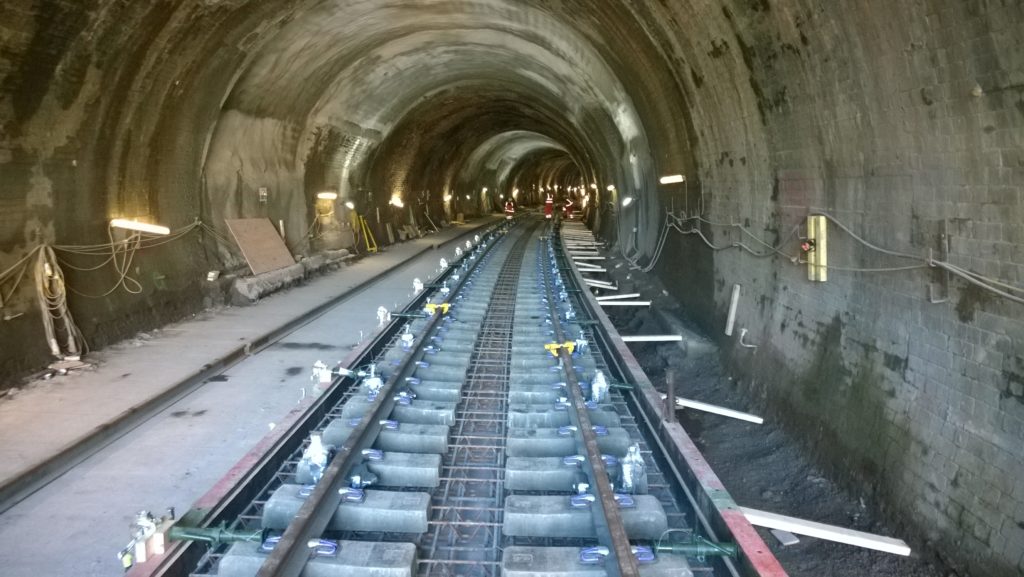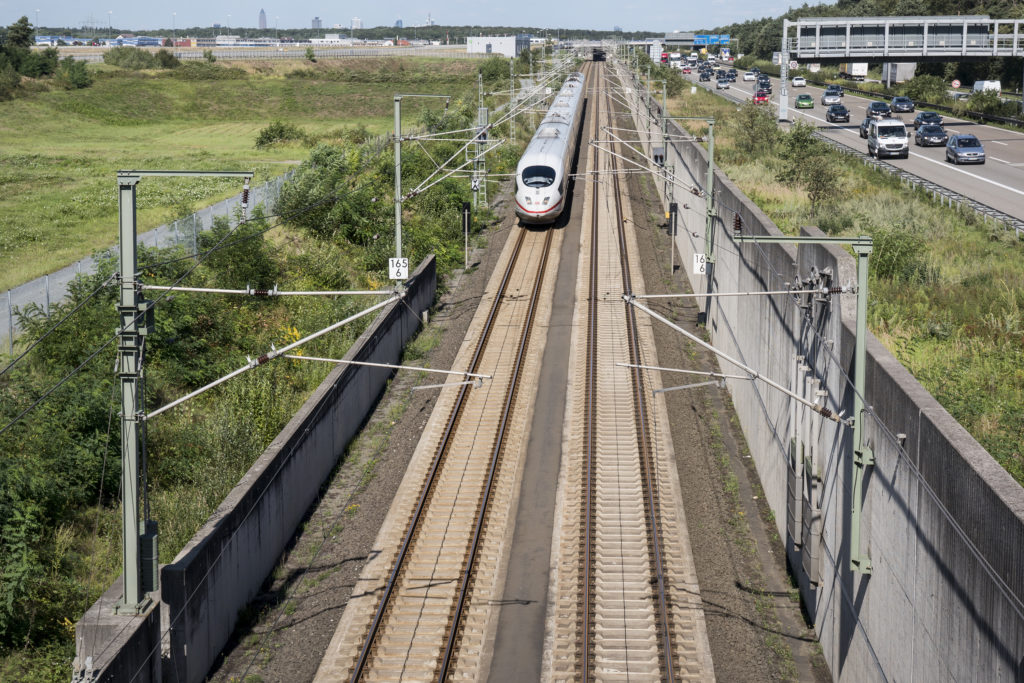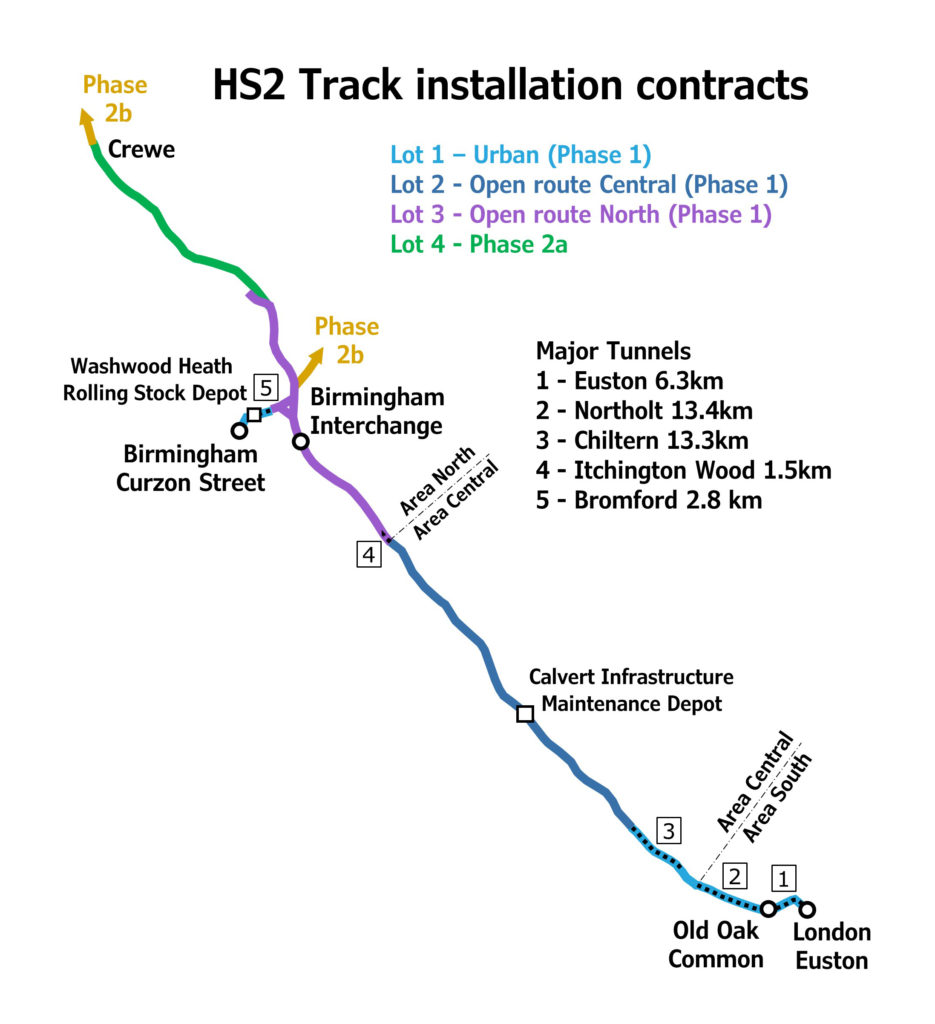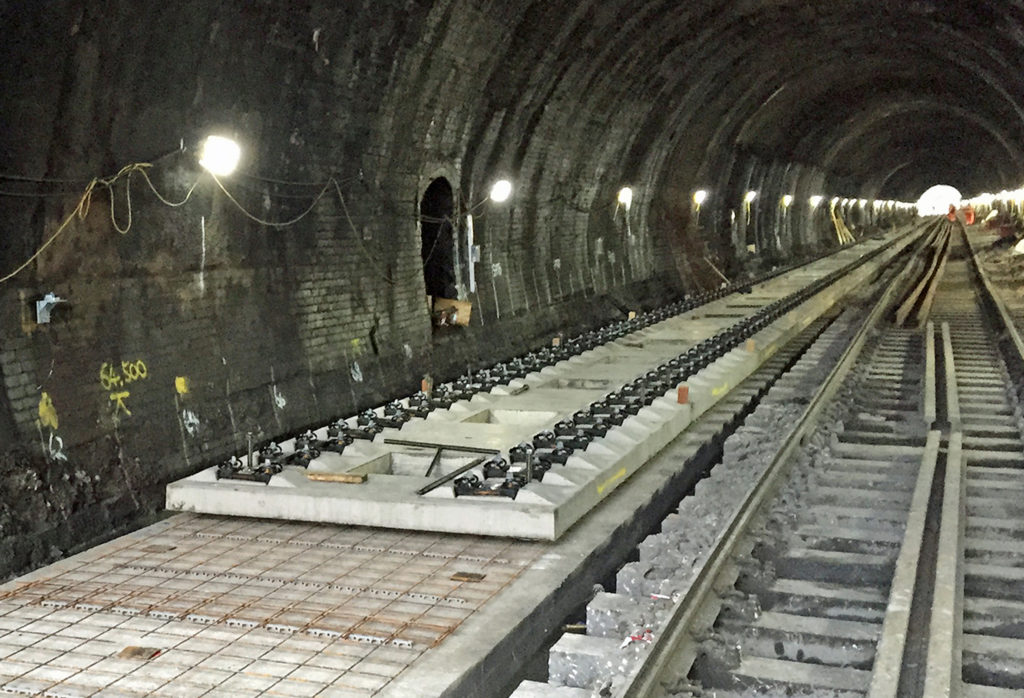Early railway track carried trains running at 50km/h (30mph) with three-tonne axle loads. Over almost 200 years, ballasted track has been developed to the point where it can carry heavy freight trains, with axle loads of 25 tonnes or more, or high-speed passenger trains at over 300km/h (186mph). Ballasted track is relatively cheap and allows track adjustments as required. However, this advantage becomes a weakness for high-speed operation, which has demanding tolerances and high dynamic loads. In such an environment, ballasted track is at its technical and economic limits.

After the introduction of the world’s first dedicated high-speed line in Japan in 1964, it became apparent that significant effort was required to maintain track geometry. In 1972, Japanese National Railways installed a trial 12-kilometre length of ballastless track on its Shinkansen network, to consider alternatives. Since then, high-speed lines in Japan have generally used slab track, although European high-speed railways were not to take this decision until much later.
1972 also saw a trial 700-metre section of slab track, formed of sleepers cast into a concrete base, laid on an embankment in Germany. This was the first use of the now widely used Rheda system, which is named after the station where it was first installed. Prior to that, slab track was generally used in tunnels, due to concerns about settlement on embankments, deformation under load and thermal expansion on bridges.
The development of pre-cast slab systems, which offered construction benefits and reduced transmission of vibrations, started in the late 1970s when the Bögl system was first tested in Germany. Shortly afterwards, the ÖBB/Porr system was developed, in association with Austrian railways. The 1990s saw the introduction of these systems and significant development work on other ballastless trackforms.
In 1994, after maintenance issues with ballasted track on its early high-speed lines, Deutsche Bahn decided that slab track had to be considered for new high-speed and upgraded lines in Germany. This drove slab track development and, perhaps, paved the way for China’s high-speed rail boom. After opening its first high speed line in 2008, by 2018 China had a built a 29,000-kilometre high-speed rail network with over 19,000 kilometres of slab track.
A big decision
Despite its increasing use and proven benefits, ballastless track is significantly more expensive to install than conventional track. The 2014 EU research publication “Design requirements and improved guidelines for track” (available online) indicates that the construction cost of slab track can be over twice that of ballasted track.


When taking the decision about its track, or indeed any railway system, HS2 has had the opportunity to consider the extensive worldwide experience of high-speed railways throughout the world. For example, Chinese railways have many thousands of kilometres of high-speed slab track, although they do not have the long-term operational experience of ballastless track that countries such as Germany have.
A review of trackforms around the world studied the use of ballasted track on high-speed lines, which include HS1 and the Paris to Strasbourg line, phase 2 of which opened in 2017. These lines carry 14 and 11 million gross tonnes per annum (MGTPA) respectively. When HS2 phase 2 is operational, its London to Birmingham section will have up to 18 trains an hour, running at a predominant normal operating speed of 330km/h (205mph), and will carry over 60 MGTPA. This will make it one of the world’s most heavily loaded high-speed lines. Any late-running trains will run at HS2’s maximum speed of 360km/h (225mph) to recover the timetable.
HS2’s assessment of the feasibility of maintaining ballasted track, when used by trains running at this speed, concluded that cumulative tonnage was the key factor in the deterioration of the track system and therefore determined the amount of tamping required. As the life span of the ballast is a function of the number of tamps, higher tonnages require more renewals.
As a result, for HS2’s operating conditions, ballast life is likely to be around 20 years. The requirement to renew all of HS2’s track at this rate would be extremely costly, cause significant disruption and require temporary speed restrictions. Even with improved dynamic track stabilisation, hand back at over 300km/h (186 mph) is not considered feasible.
Other benefits
The track is part of a complex system with multiple interactions, particularly in respect of earthworks and structures.
HS2’s earthworks and ground improvement measures have to provide a stable base for whatever trackform is chosen. Their design needs to take account of geology, inherent properties of existing ground and geodynamics that might cause Rayleigh waves as well as earthworks to bridge transitions. From an overall system design perspective, slab track offers the benefits of shallow construction depth and reduced dead load. A further advantage is that hardspots are less of an issue, due to the inherently stiffer structure of slab track. With ballasted track, the transition between earthworks and structures can be problematic.

A potential issue is that slab track can be more prone to ground-bourne sounds and vibrations (GBSV) than ballasted track. Extensive research has been undertaken on this issue to derive track specifications that ensure GBSV is within acceptable limits – slab track systems have specific features that address this issue. However, GBSV can be a particular problem in tunnels, especially for buildings above them. For this reason, HS2’s urban track installation contract, which includes all tunnels in urban areas, specifies in-situ cast track designed to minimise GBSV.
A further, not-so-obvious benefit of slab track is that its use significantly reduces the area needed for the infrastructure maintenance depot at Calvert, which then doesn’t need to accommodate ballast and tamping machines. Instead of these expensive assets, which have high maintenance costs, the machinery required for slab track maintenance is, typically, relatively simple gantries and concrete pumping machines.
Another benefit of slab track is that it eliminates the problem of flying ballast on high-speed railways, caused by a combination of air turbulence and ground bourne vibration, which can be a safety hazard and cause damage. In addition, there are workforce health and safety benefits from reduced exposure to dust, almost eliminating hand-arm-vibration, less working in proximity to machinery and a reduced chance of slips, trips and falls.
For the above reasons, HS2 concluded that, although ballasted track would be less expensive to install, slab tracks will have a lower whole-life cost, a lower whole-life carbon footprint and will avoid the need for the unacceptable disruptive maintenance and renewals associated with ballasted track. HS2 must take a long-term view and so, rightly, chose slab track.

Pre-cast or in-situ
Having decided not to use ballasted track, the next decision was what type of slab track should be used. HS2 decided that it would use a pre-cast system, as this offers quicker installation with programme flexibility. Furthermore, unlike in-situ cast track, it enables track defects to be repaired within HS2’s five-hour overnight maintenance window (eight hours at weekends). The need for such quick repairs was demonstrated in October 2018, when a train caught fire on the Cologne to Frankfurt high-speed line, near Dierdorf, closing the line for eight days. The intense heat of the fire caused significant damage to the slab track which had to be repaired before the line could be reopened.
For these reasons, HS2 ruled out widespread use of cast-in-situ slab track, such as the Rheda system, in which sleepers and steel reinforcement are cast into a concrete slab, as this requires rails to position the sleepers.
The alternative system of pre-cast panels only requires equipment that is easily transportable. This offers the opportunity to lay the track slab simultaneously at multiple worksites. Another aspect that makes this possible is that this method of installation does not require the final rails to be in place, so they can be delivered later along the formation from a railhead.
Although great care must be taken with the surveying, the lifting gantries and grouting equipment needed to install pre-cast panels is relatively simple. Also, with hundreds of structures between Birmingham and London, it is almost inevitable that there will be some programme misalignment. Hence, it is important that track laying can leap-frog over any gaps in the formation.
Pre-cast panels are designed to be easily replaced within the available five-hour maintenance window. This requires removal of the rails, breaking the panel away from its base grouting layer, replacing the panel, grout it in position and leave it to set for three hours, re-rail and open the line at line speed the next morning. This system also allows for minor settlement as, within limits, the fastening systems can be adjusted. For more significant movements, panels can be removed, jacked up and re-grouted.
Track contracts
Before they can bid for the track installation contracts, prospective contractors need to know which pre-cast slab system is to be used. Hence, the £200 million contract for the design, manufacture and supply of pre-cast slab track panels must be let several months in advance of the procurement of the track installation contracts, which will be let in 2022.
For this reason, the track systems contract needs to be let early in the programme. Hence, in May, HS2 announced that it had invited tenders for a track systems supplier that will design and install around 280 route-kilometres of pre-cast track slabs, or around 80,000 panels, to be laid in a 20-month track construction window. The required pre-cast system must be able to carry traffic at designated loads and speeds; meet the specified reliability, availability and maintenance requirements; have comparatively low whole life costs; allow slab renewals within engineering access windows; accommodate earthworks settlement within specified limits and facilitate high-quality production-line methods of construction.


The track systems contractor will be responsible for ensuring that its design ensures product approval and meets TSI requirements. It must also produce construction documentation to ensure that the track installation contractor installs the system to the required standards. The intention is that the track systems supplier will become a sub-contractor of the track installation contractor during the manufacture and supply of the pre-cast slabs.
There will be four track installation contracts that will lay track as shown in the table. The track systems contractor is responsible for the design and supply of pre-cast slab track. The installation contractor for the Lot 1 (urban area) contract is responsible for laying cast in-situ track in tunnels. This will require the mitigation required to minimise GBSV in accordance with HS2’s specifications. The ballasted track to be laid by the Lot 3 (open route) contractor is for connection to Network Rail’s existing infrastructure.
On the open route, except for on bridges, the track will be laid on an impermeable protection layer of high-quality granular material to protect earthworks from frost and water ingress by directing water to the drainage system. This protection layer, and the primary drainage, will be installed by the main works civils contractor.
The track installation contractors will then use paving machines to lay a concrete layer on top of this protection layer. As described later, the pre-cast panels are installed on top of this layer.
The shortlist
HS2’s website shows that the ITT shortlist for the track systems contract comprises two partnerships, each of which is between a pre-cast slab system pioneer and a UK construction material supplier. These are the joint venture between Tarmac and Max Bögl, formed in 2016, and a partnership between Aggregate Industries UK and Porr Bau.
The pre-cast slab system offered by Max Bögl is known as the FFB Bögl system. This is a development of a 460-metre trial prefabricated design that was laid in Karlsfeld Germany in 1977.


Porr Bau’s system is also known as Slab Track Austria, as it was jointly developed with Austrian Railways. Its oldest section has been in use since 1989.
The original trial tracks laid by both companies are still in use and have been maintenance-free since their installation. Superficially, both systems look quite similar. The Porr slab is 160 mm thick and 5.2 metres long and has eight pairs of rail fastenings. The longer 6.45 metre FFB Bögl slab is 200mm thick has ten pairs of fastenings. Both systems are laid on a concrete base that is, typically, 300mm thick.
The visual differences between the two systems are that the Porr slab has two rectangular grout holes while the FFB Bögl slab has breaking points between each pair of rail fastenings, to prevent uncontrolled crack development.
The Porr slab has two 920mm x 640mm tapered grout holes through which the self-compacting concrete is poured to fill the 40mm gap between the elastomeric layer on the bottom of the slab and the concrete base. Before the pour, the slab is accurately positioned using five jacking screws (one at each corner and one in the centre) and reinforcement is placed in the tapered grout hole. When hardened, this tapered joint helps anchor the slab vertically and horizontally.
The FFB Bögl slab also incorporate spindles for the final adjustment of the slab, which is first positioned by Bögl’s slab positioning system. The 50mm gap between the slab and base layer is filled with a specially developed cement-bound non-shrinking grout that has good flowing and compaction qualities. The slabs are joined by turnbuckles, whereas there is no connection between the Porr slabs, which have the tapered grout holes for anchoring.
Worldwide experience
Over the past 30 years, much track has been laid used using both the FFB Bögl and Porr systems. Of the two, the FFB Bögl system has had more worldwide use due to a technology transfer agreement with China, which resulted in its use for high-speeds lines such as Beijing to Tianjin (116 km) and Beijing to Shanghai (1,318 km). However, whilst there are thousands of kilometres of FFB Bögl track in China, in Europe there are only around a couple of hundred kilometres, mainly parts of German high-speed lines such as a 35-kilometre section of the Nuremburg to Ingolstad line.


Although there are no Bögl slabs installed on the UK network, the Tarmac/Bögl JV set up a 52-metre-long section of its FFB track at Tarmac’s Alrewas Quarry in 2018, for students from the National College for High-Speed Rail.
As of 2018, Porr Bau’s slab track system has been used to lay 782 kilometres of track worldwide. Apart from 165 kilometres in Doha, this has all been in Europe, with Porr slabs used for 281 kilometres of track in Austria and 320 kilometres of track in Germany. In the UK, the company’s pre-cast slabs have been used to achieve electrification clearance in Winchburgh tunnel (issue 130, August 2015) and on two track sections and a tunnel for the Gospel Oak to Barking project (issue 143, September 2016). The Porr system was also used in Glasgow Queen Street tunnel to replace a deteriorating slab track that was almost 50 years old (issue 142, August 2016).
Both pre-cast slab track systems have a good track record. Yet, when assessing the experience of the prospective suppliers, HS2 will also have to consider the capabilities of the UK collaborators in these partnerships. These will have to supply huge quantities of construction materials, using around 700,000 tonnes of concrete for the manufacture of the pre-cast slabs, which will consume about a tenth of the UK’s total annual cement production.
In evaluating these bids, HS2 has much to consider in what could be a close contest. Whatever the result, it is clear that HS2’s trackform decision will be thoroughly evaluated and informed by the worldwide experience of installing and maintaining thousands of kilometres of high-speed track over the past decades.
At least, Britain’s late membership of the high-speed rail club has had some advantages!


Thank you for this informative video, updating the readership on this unique and fascinating project.